
15 Marketing Psychology Principles To Influence Consumers
Understanding your target audience is one of the most critical elements of a successful marketing strategy. Learning their habits, behavior, and most prominent pain points enables businesses to promote their products/services to them effectively.
Consumers’ purchasing decisions are also driven by unconscious factors we can’t usually control. Unveiling and applying them to your marketing tactics will help you stand out from the competition and gain your customers’ trust.
Marketing psychology is in charge of understanding these secret parts of consumer behavior. Together, we’ll explore its main principles to enlighten marketers who want to go the extra mile.

The easiest and most affordable email marketing and newsletter software!
What Is Marketing Psychology?
Marketing psychology is the process of enclosing important psychological principles in different marketing methods, from content marketing to email campaigns and design.
This term is often used interchangeably with consumer psychology and is usually powered by the findings of neuromarketing. Thankfully, you don’t have to be a marketing psychologist to understand how to apply them to your daily marketing processes. No matter how complex human behavior is, most of the presented principles are easy to grasp.
Before diving into this field, it’s important to remember that your end goal is to influence consumers, not manipulate them, as the latter would be unethical and misleading. Always ensure that your products/services offer what they promise and that your marketing practices don’t cross the line. Without this parameter, you’ll lose your customers’ trust now or later.
And now that intentions are clear, let’s see the psychological marketing tactics that will increase conversions and sales!
1. Social Proof
Sometimes, consumers feel lost in an endless ocean of products/services, which can impact their decision-making in many ways. In these cases, they often resort to their friends and peers to get their opinions and clear their minds.
Social proof was introduced by the academic psychologist Robert Cialdini, who noted that humans turn to copy other people’s actions in specific contexts, especially people they like or trust. Influencer marketing relies heavily on this principle, as people prefer and choose what their favorite influencers suggest.
How can you make the most of this human tendency? You can start collecting reviews, case studies, and testimonials from top customers and make them accessible to prospects. Sprinkle them inside your website and even add a dedicated section where people can learn what others believe about you.
Here’s how Tea Story did it on their homepage:
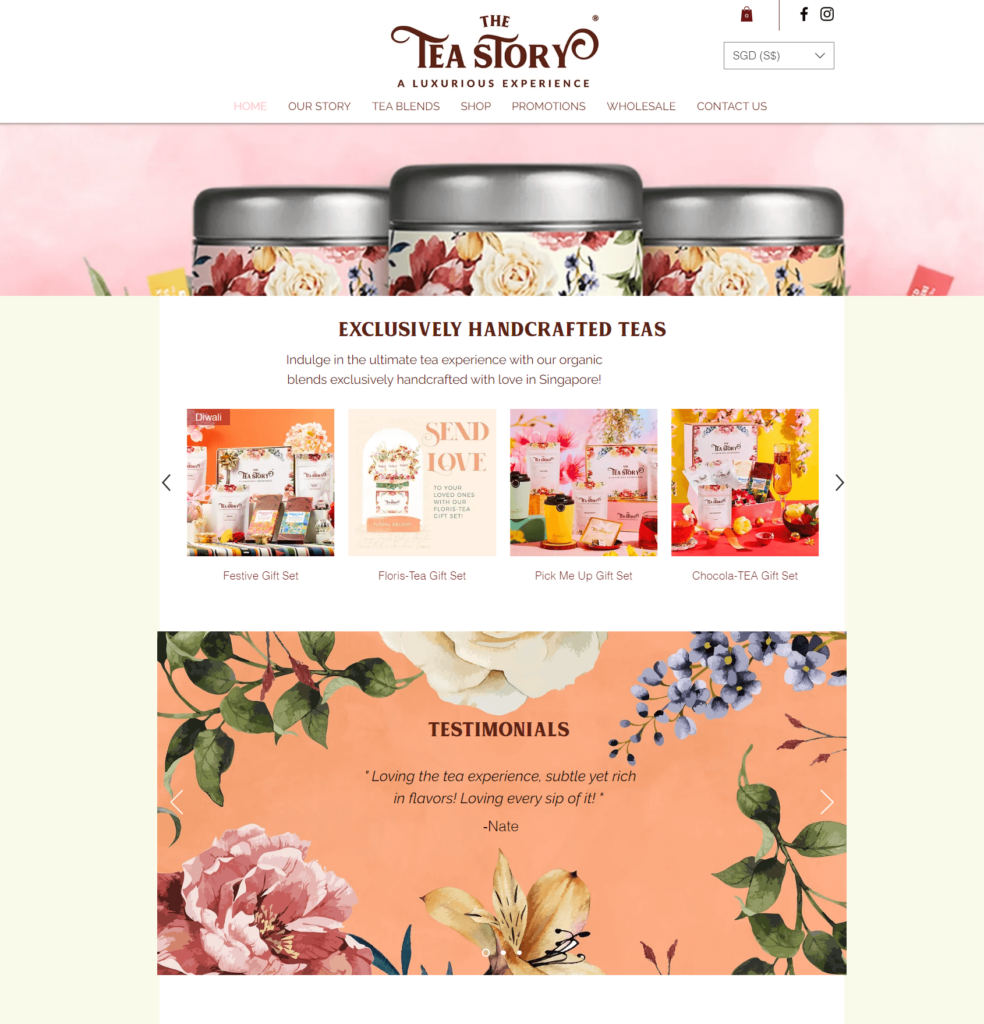
You can also create email campaigns, retargeting ads, blog posts, or additional digital marketing assets you believe potential customers will run into the most, especially those closer to the decision stage of their customer journey.
Collaborating with top social media influencers in your niche is also a great practice. Just make sure to target the same consumers for top results. Moreover, if you have received certifications and badges from experts in your industry, showcase them proudly to your audience to show your authority in your niche.
At Moosend, we send a dedicated email campaign to tell our customers and prospects the great news:
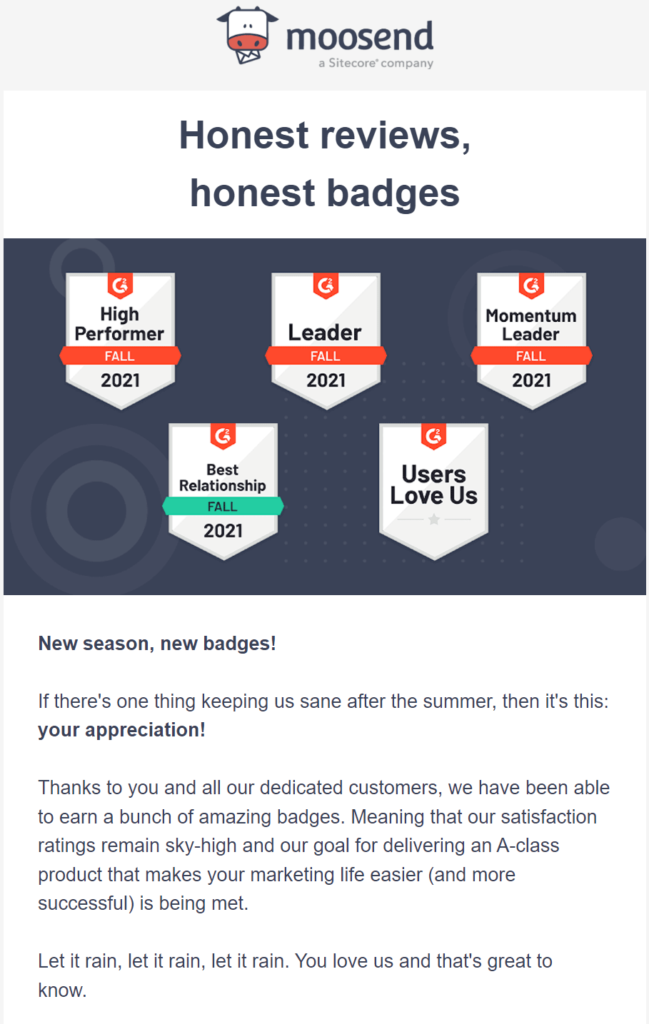
2. Paradox Of Choice
According to Schwartz’s theory about the paradox of choice, when people are presented with more options than they can process, they tend to abort the mission. So if you believe that the more you provide to customers and prospects, the better, maybe you should think twice.
To help your customers and prospects overcome analysis paralysis, giving them fewer choices of great quality is best to help them decide faster what their best option is. This marketing psychology tip applies to physical and eCommerce stores when creating product categories.
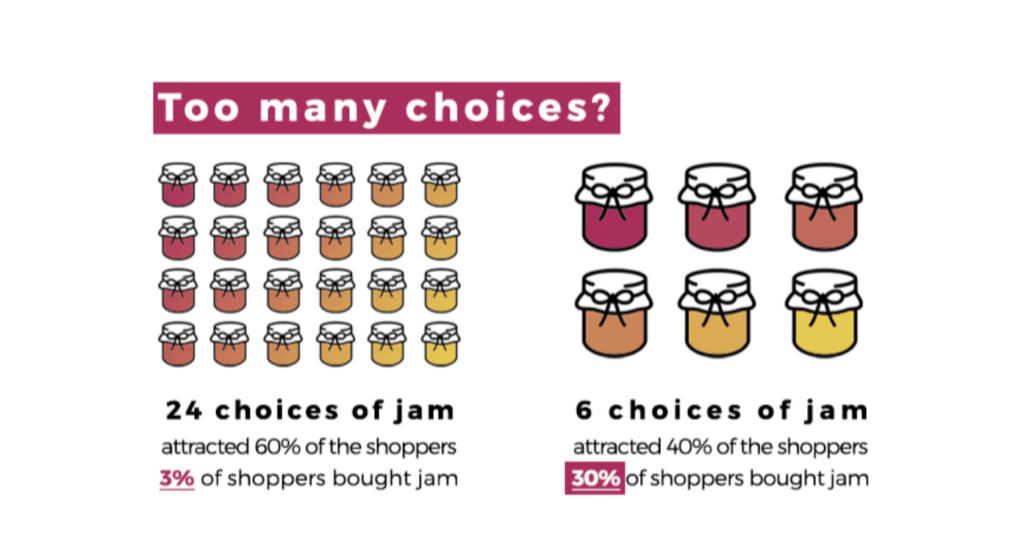
As the above image suggests, too much choice brings too much noise. Even if this means that you’ll attract more customers at the beginning, dropout will be just around the corner. So keep that in mind when arranging your store or building your product menu.
Look at this online navigation bar from Bliss. Their product categories are clear, followed by drop-down menus to select sub-categories and products:
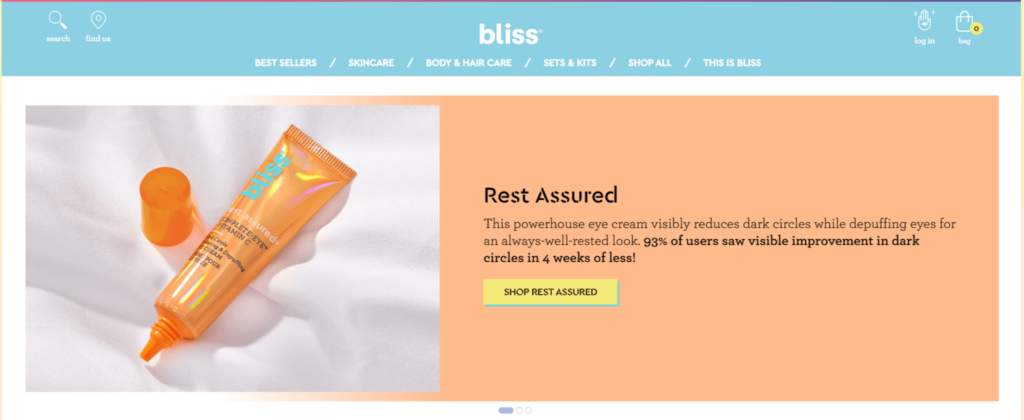
Overall, remember that our brain favors simpler forms of information, so techniques such as clustering and grouping always help.
3. Scarcity
Scarcity marketing relies on peoples’ tendency to label rare items as valuable. This is based on the economic principle that when the supply decreases, the demand gets higher.
This phenomenon triggers the so-called fear of missing out (FOMO) and gives customers a sense of urgency to purchase before it’s too late. So how can a marketer encapsulate this marketing psychology theory to increase conversions and sales? Let’s see some tactics:
- Limited-time offers: Create campaigns specifying the expiration date and time.
- Limited items in stock: Specify how many items are left to make customers act fast.
- Countdown timers: Add timers to your campaigns to remind subscribers/visitors of the timeframe.
Do you want to see an example that works wonders? Look at this amazing email campaign from Casper. The sense of urgency starts from the subject line, and when subscribers open the email, they land straight on the timer:
Subject line: Last day: Save 15% with our best offer ever.
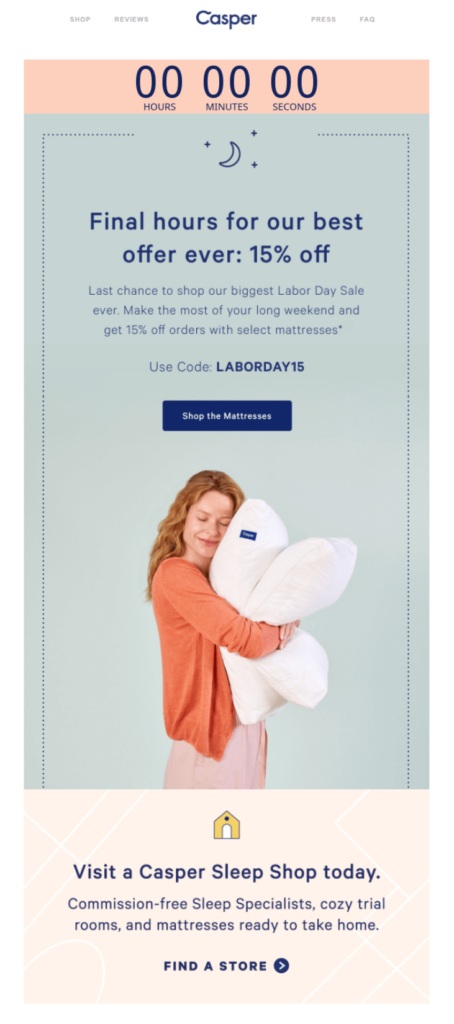
Do you want to create similar campaigns to boost your conversion rate? Sign up for a free Moosend account, customize one of our premade templates, and add the timer in simple steps.
4. Anchoring
You’ve probably heard that first impressions matter. According to Kahneman and Twersky, the main reason is that people usually base their decision-making on the first information they receive about specific items.
This cognitive bias is called anchoring and is related to complex thinking. Marketers can rely on this bias when presenting the prices of a product, especially during sales season. When the customer sees the initial sales price and the discount, they become more attracted to it, which is sometimes irrelevant to the product’s actual worth.
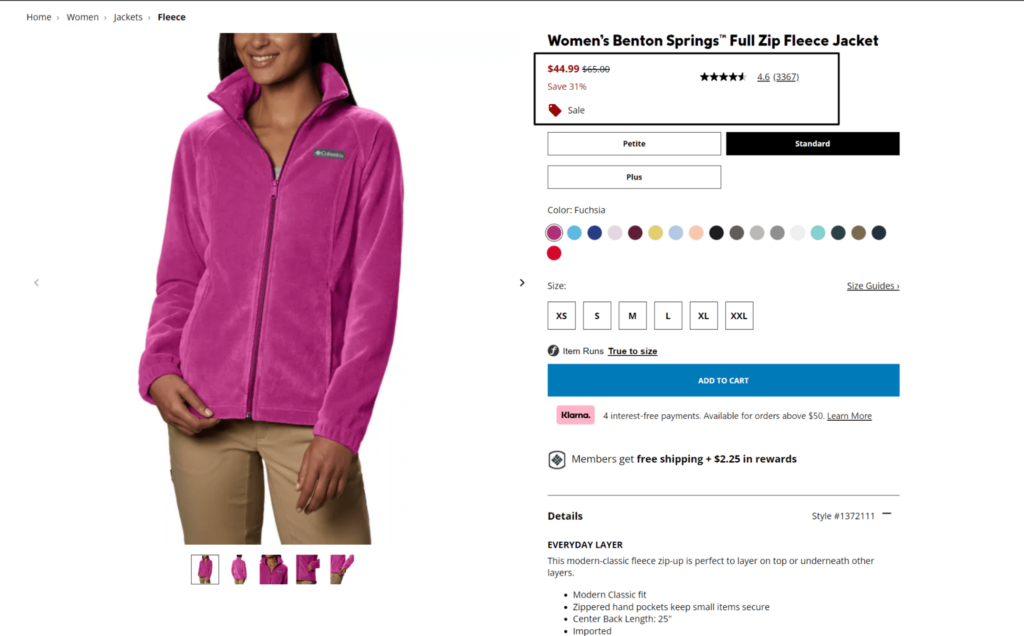
Many SaaS businesses use the same technique, presenting annual vs. monthly plans to entice prospects to stick to the long-term option. Other marketers add a special price for items bought in bulk, showing that they will maximize their savings.
5. Priming
Our unconscious minds work in very complex ways, and so does our memory. We are inclined to react to certain stimuli in a particular way based on the representation we have in our minds from previous stimuli.
How can you use this principle to affect consumer decisions? You can use subtle cues to lead your customers in the right direction. Everything starts with your storytelling and design. What words do you use to describe your brand and products, and how do they make customers feel? Overall, positive associations are stronger than negative ones in these cases.
Let’s think about Red Bull for a moment. Everyone associates this brand with energy and a feeling of freedom. All their marketing efforts, from event sponsorships to commercials and generic online presence, emphasize these elements to support associations in people’s minds with similar needs.
The video below says it all:
6. Powerful Words
The power of storytelling is well-known in marketing psychology. The words you use for your slogan and campaigns can inspire consumers, cause strong emotions and even motivate them to take the desired action.
As discussed in the previous section, words can also contribute to priming and trigger familiar and positive associations in people’s memory. Let’s see some phrases and words that can make a difference for various purposes:
- Exclusivity: Members-only, VIP, Secret, Confidential, Be the first to hear about
- Sense of community: Become a member, Come along, Join us
- Urgency: Right away, Hurry, Quick now, Asap
- Simplicity: Basic, Easy, Step-by-step, Beginners guide, Ready-made, Save time
Here are some top brand slogans that have made a real impact on customers and prospects:
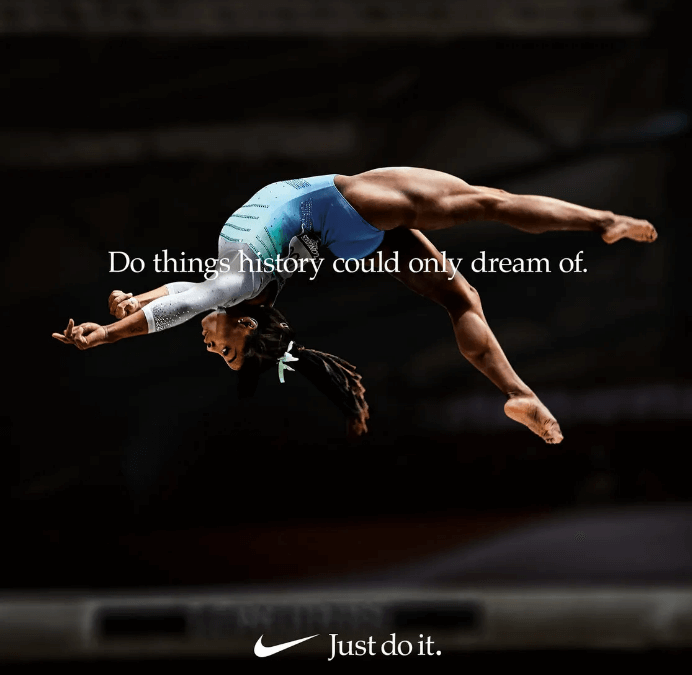
“Just do it” – Nike
“Think Different” – Apple
“Finger-lickin’ good” – KFC
“Belong anywhere” – Airbnb
“Because you’re worth it” – L’oreal
“The Citi Never Sleeps” – Citibank
If you want to find out more about marketing powerful words, read our comprehensive guide.
7. Color Psychology
Apart from words, colors can also affect people’s behaviors and moods. Specialists have been researching what emotions different colors can trigger to help marketers and designers find the most representative ones for their logos and additional marketing assets.
The image below includes many famous logos and what emotions their main color trigger to guide you:
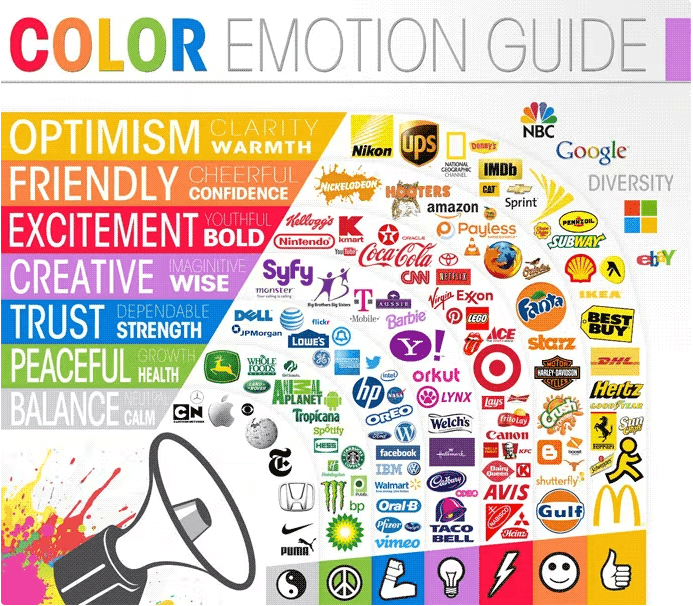
Finding the right colors for your brand will let you differentiate your business from competitors over time. It becomes your trademark and sticks to your audience’s heads. Your color palette will display your brand personality and your name, and they should complement each other.
Think about Starbucks and Coca-Cola – everyone can recognize their logos quickly. Mimic their branding approach in terms of coloring, and the sky will be your limit.
8. Commitment & Consistency
Another marketing psychology theory is based on the commitment and consistency principle suggested by Cialdini in his book “The Psychology of Persuasion.” In short, people tend to display consistent behaviors with their beliefs and values, which can also apply to consumer behavior.
According to this theory, the good news is that it’s hard to lose your loyal customers once you win them. But how can you benefit from this principle at the beginning of the funnel? Let’s see some techniques that can do the trick:
- The foot in the door: Start with small requests (e.g., completing contact forms) before asking for bigger ones (e.g., referrals).
- Free trials: When someone becomes familiar with a well-designed product/service, it’s hard to say goodbye after the trial ends.
- Wishlists: Consumers become more attached to items added to their wishlists.
- Home try-on: Consumers are usually highly likely to keep items already delivered to them – check the example below by Warby Parker.
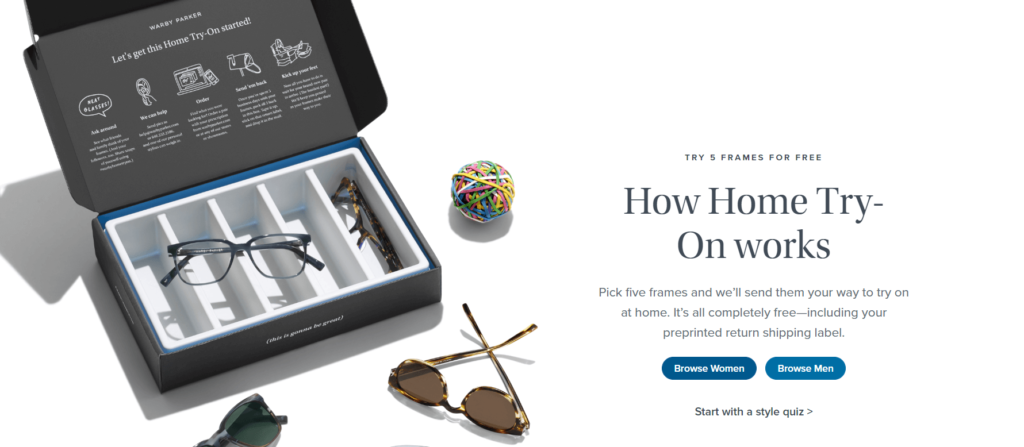
9. Visual Enhancement
You’ve probably heard that an image is worth a thousand words – this also applies to marketing psychology. Our brains seem to prefer images as we can process them faster than big blocks of text. That’s why a creative and resourceful design team is a real asset to your business.
Plus, considering how much our attention span has reduced over the years with our busy lives, you need powerful visual storytelling to convince consumers that you have the best products/services for them.
To maximize your campaign results, add visuals to all your marketing assets, from content marketing to social media and emails. This way, you can capture your customer’s attention and share a meaningful story with them.
Moreover, aligning your imagery, GIFs, and videos with the rest of your branding is important to create consistent experiences for your audience. Let’s see an email campaign from Magic Spoon for inspiration:

From the images of this campaign, you can sense how delicious and healthy their products are and also get a view of the amazing branding with playful colors.
10. Reciprocity
Have you ever felt you have to return a favor to a friend who has done something special for you? According to Cialdini and the reciprocity principle, people are usually wired to give something back for something they received.
This theory can also be replicated in the marketing field in many ways. The main gist is that if you want consumers to do something for you, be it conversion or purchase, you should do something for them first. Let’s see what tactics you can try to benefit both sides:
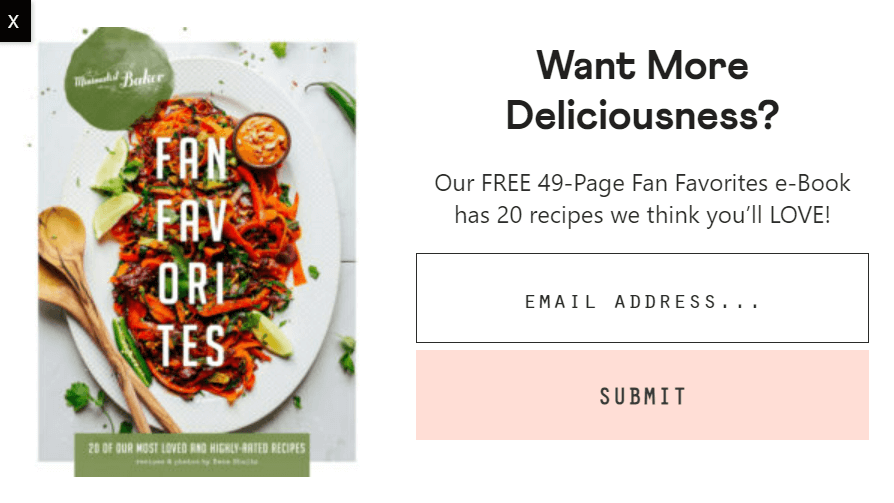
- Lead magnets: Create and share free blog posts, guides, and checklists in exchange for email addresses – check the above example from Minimalist Baker.
- Free product samples: Provide consumers with mini versions of your products.
- Consultation/Demo: Showcase your services to prospective clients.
- Discounts/Offers: Give discounts to customers highly likely to convert.
Overall, the more generous you are with customers and prospects, the more loyal they’ll be. However, remember that quality is above everything else, and ensure it’s always high on your list.
11. Empathy
If you want to influence consumers and customers and get them closer to your brand, you need to gain their trust first. To make this happen, the most important thing is to understand their real needs and pain points and address them correctly.
As the title of this section suggests, it’s important to write your messages empathetically to show customers that you care about their needs and do your best to fulfill them. Thus, you’ll make them feel more secure, relieved, and happy.
Moreover, supporting cause-related marketing initiatives will allow your brand to make an impact on the world and gain visibility at the same time.
For example, Dove is a master of empathetic marketing, displaying concepts such as body positivity and self-love. Look at their amazing campaign to raise awareness for social media’s toxic influence:
12. Decoy Effect
In this section, we’ll focus on another marketing psychology principle many businesses use for their sales strategy. The decoy effect occurs when the preference between two options is defined with the appearance of a third asymmetrically dominant and less attractive option.
If you’re confused, the example below will clear your mind:
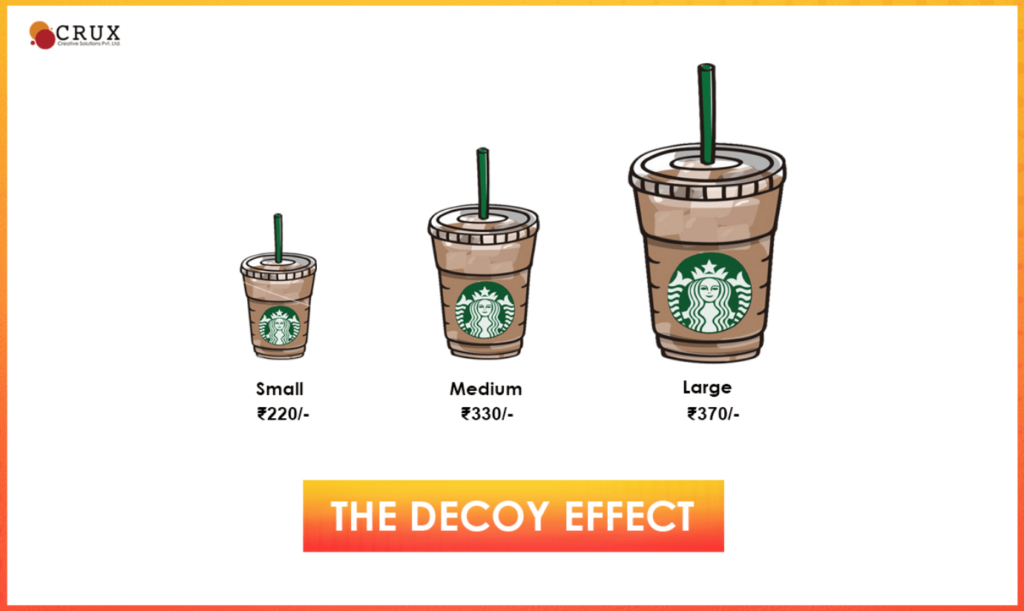
Which cup is a customer more likely to purchase? Here, the decoy variable is the medium-sized cup tempting customers to go for the large portion for a seemingly more decent price.
Therefore, if you offer products in similar tiers, try this method to increase your sales and experiment with different prices to find the perfect fit.
13. Loss Aversion
Apart from the anchoring effect, psychologists Daniel Kahneman and Amos Tversky also studied how the perception of loss can impact people’s decision-making. In short, loss aversion shows that people prefer avoiding losses to gaining new things.
How can you benefit from this human tendency in your marketing strategy? Let’s see:
- Sense of urgency: Add the expiration date and prompt them to act fast.
- Fear of missing out: Emphasize the losses according to their pain points.
- Ownership: Show them they already own your products/services and prompt them to retain them.
- Scarcity: Explain to them that they’ll gain something rare or unique.
This example by Hers tries to address this cognitive bias. Starting from the subject line, they add a timeframe to motivate subscribers to claim sales fast and continue in the same copywriting format. Using phrases like “Ends today” and “Shop now,” they remind them that if they don’t act fast, they’ll lose the amazing offers.

14. Verbatim Effect
What does this psychological tactic with this fancy name try to imply? When people communicate, they are inclined to remember the gist of information and often override the details and the conversational format.
Therefore, when presenting information to them, avoid writing long blocks of text and go with simpler forms. Think of the CTA buttons and mission statements – one of the main reasons they stand out is that they’re short and digestible, and people can memorize and process them faster.
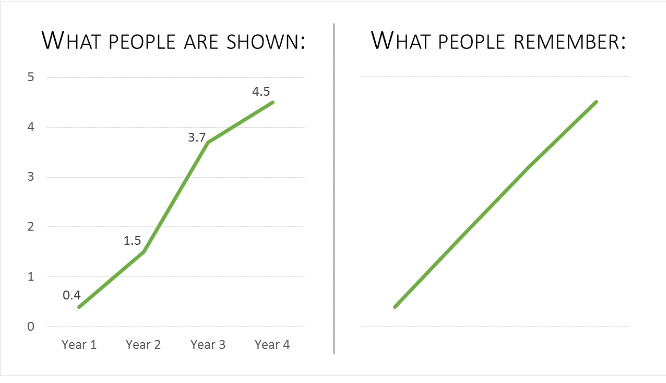
You can also write the sentences or words you want people to memorize in bold to attract their attention faster. Plus, when creating long-format texts, it’s best to include a table of contents and clear headlines that summarize the main content of each section to help hurried readers get to the point faster.
15. Information-Gap
Last but not least, we have the information-gap theory, which suggests that when the audience finds a topic interesting, they are inclined to look for more information. And, of course, it’s worth giving it to them to stay ahead of the curve.
This theory is helpful, especially for content marketers and copywriters who want to attract the readers’ attention to increase conversions for blog posts and landing pages. For example, headlines and copy starting with “How to” or “Learn how,” along with rhetoric questions to emphasize that effect.
Here’s an example from our Moosend blog that tries to meet this theory:
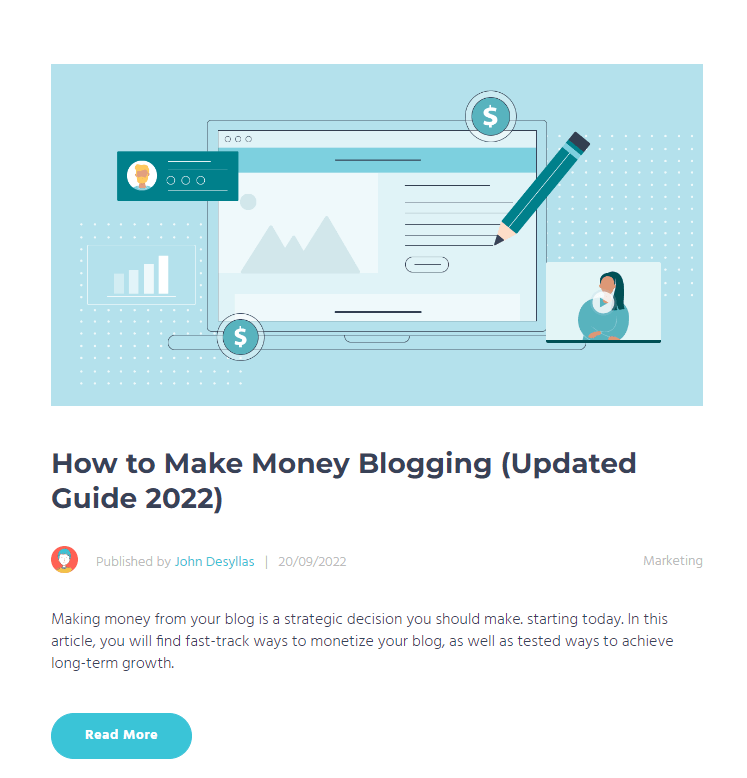
Marketing Psychology To The Rescue
Long story short, there are many marketing psychology tactics you can apply to your marketing strategy to influence consumer behavior. Find the ones that suit you best and see how they work for your audience.
Remember that your goal is not to manipulate customers and prospects but to influence them. This way, you’ll write messages that stick to your readers’ heads.
Are you looking for an email marketing platform to spread your messages to customers and prospects? Sign up for a Moosend account today and reap all its benefits.
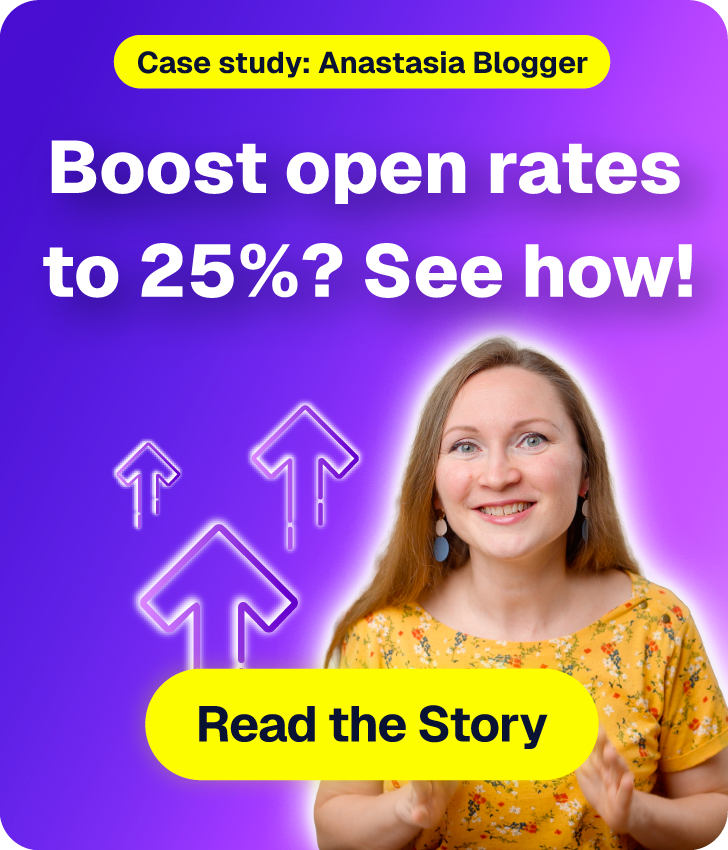
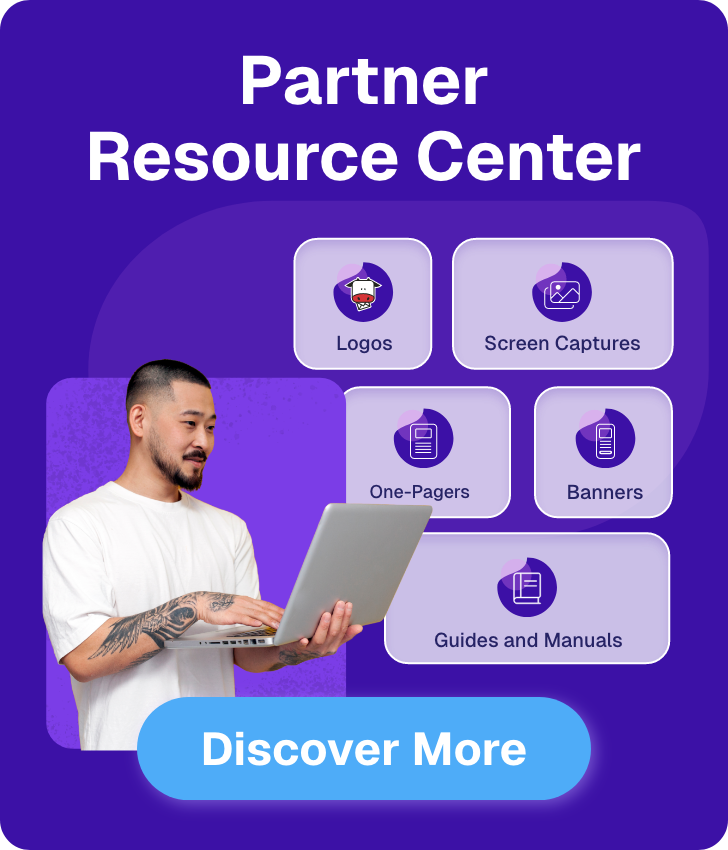



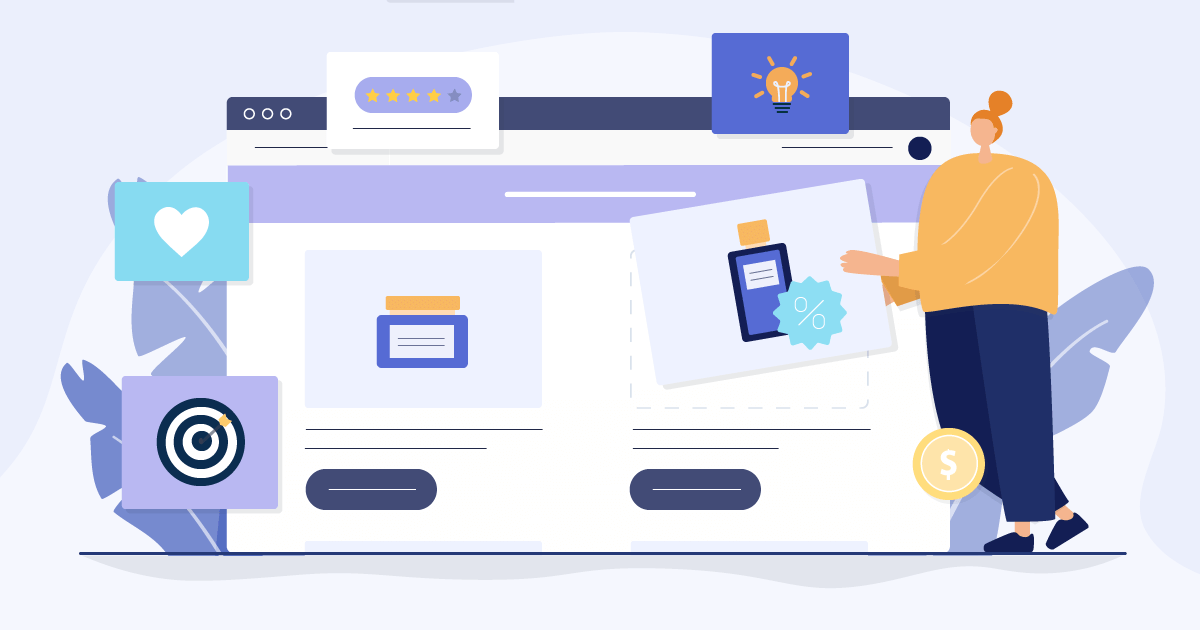
 Published by
Published by